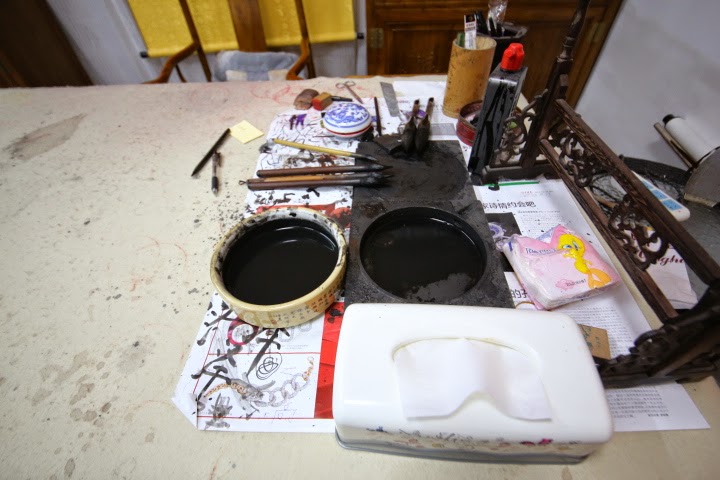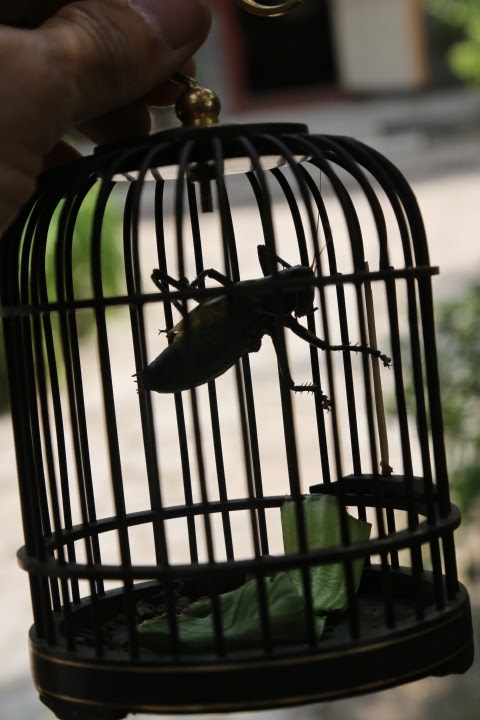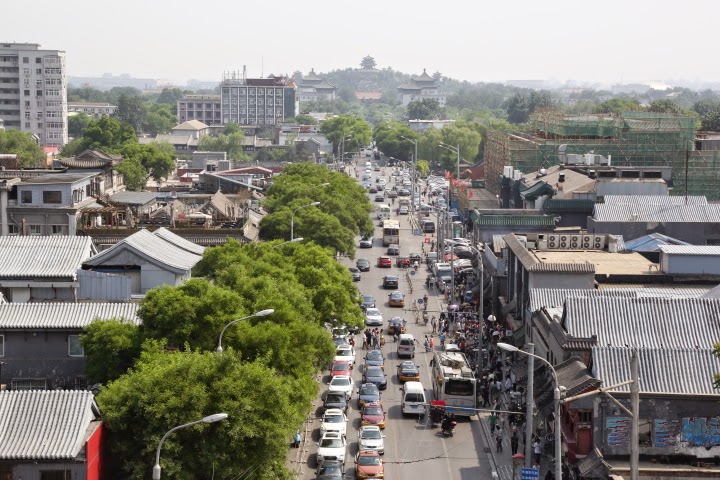Paragraphing is haywire here...
The next day I slept in: I wrote and rested and didn't leave the hotel until 11:30 am. Barbara had chosen to return to the Great Wall to explore the East side. I decided to visit the Bell Tower and the Drum Tower that afternoon, which had been recommended to me by an Australian woman I had met in the Sacred Music section
The next day I slept in: I wrote and rested and didn't leave the hotel until 11:30 am. Barbara had chosen to return to the Great Wall to explore the East side. I decided to visit the Bell Tower and the Drum Tower that afternoon, which had been recommended to me by an Australian woman I had met in the Sacred Music section
of the Temple of Heaven the day befo.
But he had an agenda. First he showed me the "Flower Door,"
then he took me to the last residence of "Queen House," apparently a well-known Beijing figure of the 1920s through 1940s. This was most a photo exhibit, but included a calligraphy desk with beautiful examples of large Chinese calligraphy on the wall--all for 10 yuan.
Next he took me to a venerable resident of the neighborhood, a woman in her sixties who lived in her childhood home with her 95-year-old father, two large grasshoppers in cages hung on a tree in their yard, some koi in an outdoor pot, two turtles in another pot, and their memories--well archived in photographs and documents. She posed for me holding 8x10s of herself as a child. I was shown all of this and met her father in the kitchen--all for 20 yuan. I certainly didn't object to the price; I never would have known about these private residences, and here I was meeting essentially bourgeois survivors of two revolutions. Also, I got to see the legendary orthopterans in cages (often represented as crickets), which pleased my childhood soul.
My driver wanted more money when he dropped me off at the two towers, but his crassness offended me, so I insisted he give me all the change from my 100 yuan note. He gave me 19 yuan, and I let it go.
The two towers were very "packaged" tourist attractions. After climbing 60 steep steps. there was the immense bell (do not approach; do not touch), with billboarded historical explanations. It apparantely was rung to mark the divisions of the day, including the night--timekeeping before the widespread use of clocks, during the Ming Dynasty, which ended in 1644. The Drum Tower contained a row of drums of different sizes, and promptly at 2:30 pm five drummer appeared in traditional garb and gave us a performance lasting about 10 minutes, to general acclaim. The views were only fair, since the line of sight to the Forbidden City was blocked by a high hill with a park and temple on it, and there was a metal barrier preventing the public from walking on the parapet, the outermost observation ring. so we couldn't look directly down.
Leaving the two towers, I headed northeast, towards a Buddhist temple that had been recommended to me. After walking for about an hour I found myself in a neighborhood of Buddhist paraphernalia shops, very reminiscent of Tibet, and of high quality. Across the street was the entrance to the temple complex. It was 4:30, and of course, it closed at 5. I bought my ticket and went in.
I was back in a pious Buddhist environment, this one dominated by the burning of incense. Good sized metal tubs containing burning incense stood before each temple building emitting large quantities of smoke, with devotees standing at them tending the incense they were burning and inhaling. Inside the temples were Buddha and Lama statues I was now thoroughly familiar with, but it was good to see these evocations of Tibet in the heart of the Chinese power complex, especially given the over enmity of Chinese officialdom towards the Tibetans, whose country they expropriated, and the common stereotype among the Chinese populace that "all Tibetans are terrorists." Of course, in their pious Buddhist incarncation they're at their most harmless (if they only knew how peaceloving the Dalai Lama is).
Then inside the last temple, presumably the main one, I came upon the largest Buddha I'd yet seen in doors. It was 12 meters high, and I furtively snapped a photo, then managed to capture the row of Lamas on the right.
But the two flanking buildings held the real (art) treasures of the complex: exquisite gold statues on pious Buddhist themes, spilling over into Hindu ones, e.g. the holy copulations of multi-headed, multi-armed deities. I got to talking with a young French man, who was familiar with the Musee Guimet in Paris, the museum of Asian art, and we agreed that these pieces equaled or surpassed that museum's holdings.
The monks were gently shoving us out; it was closing time. I made my way back toward the entrance, but on the way whipped out my tripod to take some pinhole photos of the temples. I managed to fire off a few at the correct exposure, as I was being whisked out, and on the exterior concourse I met a spirited man and woman (business colleagues, I learned) who wanted to pose for me. We had some fun with my self-timer, and then two monks joined our portrait array, before we were again urged to leave the entire complex. They gave me their cards, and I sent them their photos when I got back to the hotel and received a thank-you email entirely in Chinese--the translation came two days later.
On the way home, I jumped on a bus heading in my direction--only one yuan (16 cents!)--and managed to find a young man who spoke English in time to tell me when to get off. On my way back to the hotel I passed what seemed to be a contemporary art museum, that I resolved to visit the following day--our last in Beijing.

























No comments:
Post a Comment